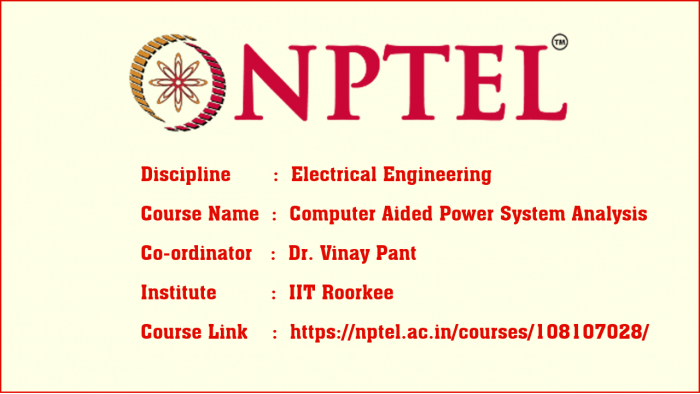
Media Storage Type : DVD-ROM
NPTEL Course Name : Computer Aided Power System Analysis
NPTEL Subject Matter Expert : Dr. Vinay Pant
NPTEL Co-ordinating Institute : IIT Roorkee
NPTEL Lecture Count : 47
Lecture Titles:
Lecture 1 - Modern power system operation and control, different types of power system analysis
Lecture 2 - Introduction, modeling of power system components and formation of YBUS matrix
Lecture 3 - Formation of YBUS matrix in the presence of mutually coupled elements
Lecture 4 - Basic power flow equations and Gauss-Seidel load flow technique
Lecture 5 - Example of Gauss-Seidel load flow technique
Lecture 6 - Newton-Raphson (polar) load flow technique
Lecture 7 - Example of Newton-Raphson (polar) load flow technique
Lecture 8 - Newton-Raphson (rectangular) load flow technique
Lecture 9 - Example of Newton-Raphson (rectangular) load flow technique
Lecture 10 - Fast decoupled load flow technique
Lecture 11 - Example of Fast decoupled load flow technique
Lecture 12 - A.C.-D.C. load flow technique
Lecture 13 - Example of A.C.-D.C. load flow technique
Lecture 14 - Introduction to Sparsity and Gaussian elimination technique
Lecture 15 - Example of Gaussian elimination technique, Optimal ordering and LU factorization
Lecture 16 - Algorithm & example of LU factorization, storage scheme for sparse matrices
Lecture 17 - ZBUS matrix formulation without mutual impedance
Lecture 18 - ZBUS matrix formulation without mutual impedance (Continued...)
Lecture 19 - Example of ZBUS matrix formulation
Lecture 20 - ZBUS matrix formulation considering mutual coupling between elements
Lecture 21 - Example of ZBUS matrix formulation in the presence of mutual coupling
Lecture 22 - Symmetrical Fault analysis & introduction to symmetrical components
Lecture 23 - Sequence networks of power system components
Lecture 24 - LG, LL,LLG fault analysis using sequence networks
Lecture 25 - Unbalance fault analysis using of ZBUS matrix
Lecture 26 - Example of fault calculations for three-phase and LG faults
Lecture 27 - Example of fault calculations for LL and LLG faults
Lecture 28 - Open conductor fault analysis
Lecture 29 - Example of Open conductor fault analysis
Lecture 30 - Introduction, concept of GOSF, LOSF and D.C. load flow
Lecture 31 - Calculation of GOSF and determination of Theveninï¾’s equivalent impedance
Lecture 32 - Calculation of LOSF with an example
Lecture 33 - Analysis of multiple contingencies
Lecture 34 - Analysis of multiple contingencies (Continued...)
Lecture 35 - Example of multiple contingency analysis and contingency ranking methods
Lecture 36 - Classification of power system stability, equation of motion of a synchronous generator
Lecture 37 - Basics of transient stability analysis with Partitioned Explicit technique
Lecture 38 - Techniques for numerical integration with modified Eulerï¾’s method and Runge-Kutta 4th order method
Lecture 39 - Example of transient stability analysis using modified Eulerï¾’s method
Lecture 40 - Example of transient stability analysis using Runge-Kutta 4th order method
Lecture 41 - Basics of Small signal analysis and linearization of network equations at generator buses
Lecture 42 - linearization of network equations at load buses
Lecture 43 - Formation of system state matrix and example of small signal stability analysis
Lecture 44 - Introduction to voltage stability
Lecture 45 - Relation between PL, QL and V
Lecture 46 - Criteria for assessing voltage stability
Lecture 47 - Appendix - A System Data

